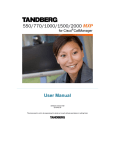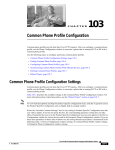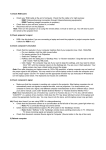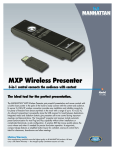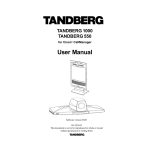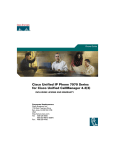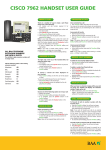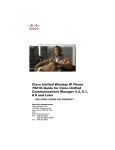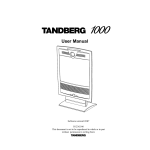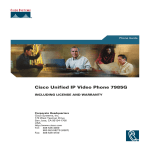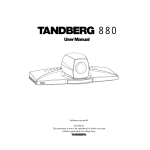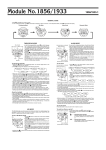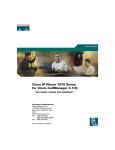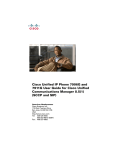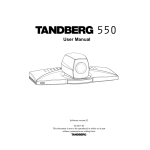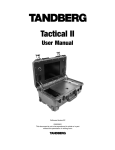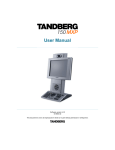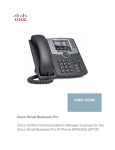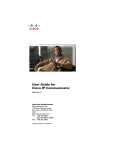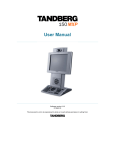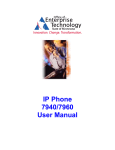Download User Manual
Transcript
User Manual Software version M1 D13742.01 This document is not to be reproduced in whole or in part without permission in writing from: D1374201_User_Manual_T550_T770_MXP_CCM Trademarks and Copyright All rights reserved. This document contains information that is proprietary to TANDBERG. No part of this publication may be reproduced, stored in a retrieval system, or transmitted, in any form, or by any means, electronically, mechanically, by photocopying, or otherwise, without the prior written permission of TANDBERG. Nationally and internationally recognized trademarks and trade names are the property of their respective holders and are hereby acknowledged. Contains iType™ from Agfa Monotype Corporation. Disclaimer The information in this document is furnished for informational purposes only, is subject to change without prior notice, and should not be construed as a commitment by TANDBERG. The information in this document is believed to be accurate and reliable; however TANDBERG assumes no responsibility or liability for any errors or inaccuracies that may appear in this document, nor for any infringements of patents or other rights of third parties resulting from its use. No license is granted under any patents or patent rights of TANDBERG. This document was written by the Research and Development Department of TANDBERG, Norway. We are committed to maintaining a high level of quality in all our documentation. Towards this effort, we welcome your comments and suggestions regarding the content and structure of this document. Please fax or mail your comments and suggestions to the attention of: Research and Development Department TANDBERG P.O. Box 92 1325 Lysaker Norway Tel: +47 67 125 125 Fax: +47 67 125 234 COPYRIGHT © 2005, TANDBERG User Manual Environmental Issues Thank you for buying a product, which contributes to a reduction in pollution, and thereby helps save the environment. Our products reduce the need for travel and transport and thereby reduce pollution. Our products have either none or few consumable parts (chemicals, toner, gas, paper). Our products are low energy consuming products. Battery handling Batteries for the Remote Control are Long Life and Alkaline batteries saving the environment; please follow guidelines on the packing material for handling and disposal of the batteries. Waste handling No need to send material back to TANDBERG as there are no consumables to take care of. Please contact your local dealer for information on recycling the product by sending the main parts of the product for disassembly at local electronic waste stations, marking recyclable parts so the waste station can disassemble and re-use these parts. Production of products Our factories employ the most efficient environmental methods for reducing waste and pollution and ensuring the products are recyclable. Digital User Manuals TANDBERG is pleased to announce that it has replaced the printed versions of its User Manuals with a digital CD version. Instead of a range of different user manuals, there is now one CD which can be used with all TANDBERG products, in a variety of languages. The environmental benefits of this are significant. The CDs are recyclable and the savings on paper are huge. A simple webbased search feature helps users directly access the information they need. In addition, the TANDBERG video systems now have an intuitive on-screen help function, which provides a range of useful features and tips. The content of the CD can still be printed locally if the need arises. D1374201_User_Manual_T550_T770_MXP_CCM Operator Safety Summary For your protection, please read these safety instructions completely before operating the equipment and keep this manual for future reference. The information in this summary is intended for operators. Carefully observe all warnings, precautions and instructions both on the apparatus and in the operating instructions. Equipment Markings The lightning flash symbol within an equilateral triangle is intended to alert the user to the presence of uninsulated “dangerous voltages” within the product’s enclosure that may be of sufficient magnitude to constitute a risk of electrical shock. The exclamation mark within an equilateral triangle is intended to alert the user to the presence of important operating and maintenance (servicing) instructions within literature accompanying the equipment. Warnings Water and moisture - Do not operate the equipment under or near water - for example near a bathtub, kitchen sink, or laundry tub, in a wet basement, or near a swimming pool or in areas with high humidity. Cleaning - Unplug the apparatus from the wall outlet before cleaning or polishing. Do not use liquid cleaners or aerosol cleaners. Use a lint-free cloth lightly moistened with water for cleaning the exterior of the apparatus. Ventilation - Do not block any of the ventilation openings of the apparatus. Install in accordance with the installation instructions. Never cover the slots and openings with a cloth or other material. Never install the apparatus near heat sources such as radiators, heat registers, stoves, or other apparatus (including amplifiers) that produce heat. Grounding or Polarization - Do not defeat the safety purpose of the polarized or grounding-type plug. A polarized plug has two blades with one wider than the other. A grounding type plug has two blades and a third grounding prong. The wide blade or third prong is provided for your safety. If the provided plug does not fit into your outlet, consult an electrician. Power-Cord Protection - Route the power cord so as to avoid it being walked on or pinched by items placed upon or against it, paying particular attention to the plugs, receptacles, and the point where the cord exits from the apparatus. Attachments - Only use attachments as recommended by the manufacturer. Accessories - Use only with a cart, stand, tripod, bracket, or table specified by the manufacturer, or sold with the apparatus. When a cart is used, use caution when moving the cart/apparatus combination to avoid injury from tip-over. Lightning - Unplug this apparatus during lightning storms or when unused for long periods of time. User Manual ISDN cables - CAUTION - To reduce the risk of fire, use only No. 26 AWG or larger telecommunication line cord. Servicing - Do not attempt to service the apparatus yourself as opening or removing covers may expose you to dangerous voltages or other hazards, and will void the warranty. Refer all servicing to qualified service personnel. Damaged Equipment - Unplug the apparatus from the outlet and refer servicing to qualified personnel under the following conditions: When the power cord or plug is damaged or frayed If liquid has been spilled or objects have fallen into the apparatus If the apparatus has been exposed to rain or moisture If the apparatus has been subjected to excessive shock by being dropped, or the cabinet has been damaged If the apparatus fails to operate in accordance with the operating instructions D1374201_User_Manual_T550_T770_MXP_CCM Table of Contents 1 Introduction............................................................................................................................... 1 1.1 At a Glance ............................................................................................................................ 2 1.2 Settings Menu Structure ........................................................................................................ 4 2 Installation ................................................................................................................................ 5 2.1 Unpacking and Mounting ....................................................................................................... 6 2.2 Connecting Cables................................................................................................................. 7 2.3 Monitor Configuration........................................................................................................... 10 3 General Use ........................................................................................................................... 11 3.1 The Welcome Menu............................................................................................................. 12 3.2 Using the Remote Control.................................................................................................... 13 3.2.1 Navigation ................................................................................................................ 15 3.2.2 Selfview.................................................................................................................... 16 3.2.3 Layout ...................................................................................................................... 17 3.2.4 Mic Off...................................................................................................................... 19 3.2.5 Volume + and - ........................................................................................................ 20 3.2.6 Number and Letter keys........................................................................................... 21 3.2.7 Touch Tones ............................................................................................................ 22 3.2.8 Softkeys ................................................................................................................... 23 3.3 On-screen Indicators............................................................................................................ 24 3.4 Camera Control.................................................................................................................... 25 3.4.1 Moving the camera .................................................................................................. 26 3.4.2 Zoom ........................................................................................................................ 27 3.4.3 Far End Call Camera Control .................................................................................. 28 3.5 Call Handling........................................................................................................................ 29 3.5.1 Placing a call............................................................................................................ 30 3.5.2 Answering a call....................................................................................................... 31 3.5.3 Ending a Call............................................................................................................ 32 3.5.4 Using Hold and Resume.......................................................................................... 33 3.5.5 Transferring a Connected Call................................................................................. 34 3.5.6 Conference Calls ..................................................................................................... 35 3.5.7 Forward Calls to another Number............................................................................ 36 3.5.8 Storing and Retrieving Parked Calls........................................................................ 37 3.6 Directory............................................................................................................................... 38 3.7 Messages............................................................................................................................. 39 3.8 Services ............................................................................................................................... 40 4 Settings................................................................................................................................... 41 4.1 View Status .......................................................................................................................... 42 4.1.1 System Status.......................................................................................................... 43 4.1.2 Call Status................................................................................................................ 44 4.1.3 View Administrator Settings ..................................................................................... 45 4.1.4 Restore Default Settings .......................................................................................... 46 4.2 Network Settings .................................................................................................................. 47 4.2.1 IP Settings................................................................................................................ 48 4.2.2 Wireless LAN Settings ............................................................................................. 50 4.2.3 TFTP Settings .......................................................................................................... 52 4.2.4 DNS Settings ........................................................................................................... 53 4.2.5 Data Port .................................................................................................................. 54 4.3 Audio Settings ...................................................................................................................... 56 4.4 Display Settings ................................................................................................................... 57 4.4.1 Screen Settings........................................................................................................ 58 4.4.2 Picture Control ......................................................................................................... 62 User Manual 5 6 7 8 4.5 Presentation ......................................................................................................................... 63 4.6 Lines..................................................................................................................................... 64 Peripheral Equipment............................................................................................................. 65 Appendices............................................................................................................................. 66 Index....................................................................................................................................... 69 Glossary ................................................................................................................................. 70 1 Introduction This User Manual is provided to help you make the best use of your TANDBERG unit. The TANDBERG 550/770 MXP for Cisco CallManager offers superior audio and video quality in a fully-featured unit. Main features Delivers the ultimate visual communication experience, with video quality developed by TANDBERG for business video applications. Full range of Cisco IP telephony functions, including Directory and Call Control, as supported by the Cisco Call Manager. Software upgradeable, to grow with the capabilities of the Cisco CallManager. Includes XML applications that deliver a range of information services to the desk top. Interoperability with ISDN networks via the Cisco CallManager gateway function Performance features. Bandwidth up to 768 Kbps. PC card slot for wireless LAN connection. New features New Graphical User Interface including new Remote Control. Far End Camera Control. H.264 video compression. G722 High quality audio algorithm. Advanced Screen Layout: Support for dual monitor setup (Side-by-Side) and Picture outside Picture support. Video source selection. 1 D1374201_User_Manual_T550_T770_MXP_CCM 1.1 At a Glance Codec The Codec is the heart of the system. The main task for the Codec is the compression of outgoing video, audio and data, the transmission of this information to the far end and the decompression of the incoming information - the name Codec comes from a combination of the two words compression and decompression. Remote control The remote control is used to control all functions of the system. If the screen saver is activated (black monitor), touching the remote control will automatically wake up the system. The remote control uses 4 AAA batteries. The system will tell you when batteries are running low. Change the batteries at the back of the remote control. The reach of the remote control signal is 20 meters. For users sitting in an open plan office, this can cause problems. Use the little, white switch placed under the batteries to change the reach of the signal from 20 meters to 2 meters. This will prevent you from unintentionally controlling your neighbor's video system, when you control your own system. Camera The built-in camera unit includes a high quality color camera with a fast pan/tilt/zoom action. The camera is controlled by the system's infrared remote control and operates pan/tilt and zoom. 2 Introduction Microphone The high quality table microphone is designed to use on a table during a videoconference. The ideal location for the microphone is on a flat surface at least 2m (6.5 ft) from the front of the system. The microphone should always be placed pointing away from the system with the cable towards the system. The system will automatically equalize sound levels. Loud and soft voices are picked up and transmitted to the far end at approximately the same level. 3 D1374201_User_Manual_T550_T770_MXP_CCM 1.2 Settings Menu Structure The settings menu structure is shown below. Press menu. 4 to enter or leave the settings 2 Installation Precautions Never install telephone wiring during a lightning storm. Never install telephone jacks in wet locations unless the jack is specifically designed for wet locations. Never touch uninstalled telephone wires or terminals unless the telephone line has been disconnected at the network interface. Use caution when installing or modifying telephone lines. Avoid using a telephone (other than a cordless type) during an electrical storm. There may be a remote risk of electrical shock from lightning. Do not use the telephone to report a gas leak in the vicinity of the leak. The socket outlet shall be installed near to the equipment and shall be easily accessible. Never install cables without first switching the power OFF. 1TR6 network type is not approved for connection directly to the telecommunications network. This network type is only to be used behind a PABX. This product complies with directives: LVD 73/23/EC, EMC 89/366/EEC, R&TTE 99/5/EEC 5 D1374201_User_Manual_T550_T770_MXP_CCM 2.1 Unpacking and Mounting Unpacking The TANDBERG 550/770 MXP for Cisco CallManager consists of the following items: Videoconferencing system Table microphone Remote control Batteries User manual on CD Cables Power supply Mounting Place the system centrally, on top of the monitor, close to the front and ensure it is stable. 6 Installation 2.2 Connecting Cables 1. Microphone Cable Connect the microphone to the microphone cable. Connect the microphone cable to microphone input 1 on the system. 2. Monitor Cable(s) Scart (Europe): Connect the Scart adapter to one of the Scart connectors on your monitor. Scart (Europe) & RCA/S-Video (US): Audio: The cable with one RCA connector on one side and two RCA connectors on the other side: Connect the two RCA connectors to your monitor (or Scart adapter) Audio Left/Right connectors (the audio signal from the system is a monaural signal and therefore is fed into both audio-in sockets on the monitor). Connect the other end to ‘Audio Out’. Video: Connect the S-video cable to the S-video connector on your monitor (or Scart adapter). If you do not have an S-video connector on your monitor, connect the RCA-RCA video cable to the RCA connector on your monitor. Connect the other end to ‘Video Out’. 7 D1374201_User_Manual_T550_T770_MXP_CCM 3. Power Cable Connect the power supply to the ‘DC in’ input on the system. Connect the power cable to the power supply. Connect the power cable to an electrical distribution socket. 4. LAN Cable To use the system on LAN, connect a LAN cable from the ‘Ethernet’ connector on the system to your LAN. 5. Wireless LAN - Insert PC Card Remove the “dummy” card by pressing the ‘Eject’ button next to the slot. Insert the Wireless LAN PC Card. 8 Installation Note! Make sure you insert the card in the right direction (with the product logo pointing upwards). Push the card into the slot until the Eject button pops up. See chapter 4.2.2 Wireless LAN Settings for configuration. 9 D1374201_User_Manual_T550_T770_MXP_CCM 2.3 Monitor Configuration Power on Power on the monitor and use the monitor remote control to select the Audio/Video input used (refer to your monitor manual). If you are using S-video from the system, remember to select SVideo input to avoid a black and white picture. Select Audio/Video input on monitor Selection of Audio/Video input used is generally performed by pressing the 0/AV button on the TV remote control several times. Please refer to your monitor user manual for further information. 10 3 General Use Wake up the system When the system is not in use, it is in standby mode and the screen is black. Wake up the system by picking up the remote control. An incoming call or pressing any key on the remote control will also wake up the system. If the system does not respond Make sure that the system is switched on by using the On/Off switch located at the rear of the system. 11 D1374201_User_Manual_T550_T770_MXP_CCM 3.1 The Welcome Menu When the system is switched on, you will see the welcome screen. The welcome screen presents the Main menu and displays your Main Camera image in the background (Main Camera is system default). The following menu will appear when not in a call. Press OK or Cancel(X) to activate or hide the welcome menu. This screen provides you with the telephone number(s) assigned to your unit. 12 General Use 3.2 Using the Remote Control The system is controlled with a remote control. Think of the remote control as a mobile phone with number keys and call keys. Use the arrow keys and OK to navigate the menu. The system’s most commonly used functions are also accessible directly from the remote control. The Infra Red (IR) sensor for the remote control is located in front of the camera. 1. Correspond with the commands at the bottom of the screen. See 3.2.8 Softkeys for details. 2. Mic Off turns your microphone on and off. See 3.2.4 Mic Off for details. 3. Arrow keys are used for navigation in the menu and for moving the camera when the menu is hidden. See 3.2.1 Navigation for details. 4. Volume + and – adjusts the system volume. (See 3.2.5 Volume + and -for details). 5. The Layout key toggles between full screen and different display layouts. See 4.4.1 Screen Settings for details. 6. Cancel takes you back one step in the menu system. Use Cancel to delete characters in an input field. See 3.2.1 Navigation for details. 7. Press the Call key to place a call. See 3.5 Call Handling for details. 8. Not in use. 9. Not in use. 10. Voice Mail – indicates that you have a voice mail that you can be retrieved. 11. Services. 12. The Presentation key switches to a predefined presentation source. See 4.5 Presentation for details. 13. Press OK/Menu to show the menu and to select menu items. See 3.2.1 Navigation for details. 14. Use Zoom + and – to zoom the camera in and out. See 3.4 Camera Control for details. 15. Selfview displays your outgoing video. Press Selfview again to turn selfview off. See 3.2.2 Selfview for details. 16. Store and recall your video contacts 13 D1374201_User_Manual_T550_T770_MXP_CCM 17. 18. 19. 20. 21. 14 via the system Phone Book for easy placement of calls. See chapter 3.6 Directory for details. Use the red End Call key to end the current call. See 3.5.3 Ending a Call for details. Number/Letter keys function in the same manner as with a mobile or cellular phone. See 3.2.7 Touch Tones for details. Help. Configuration / Administrator settings. General Use 3.2.1 Navigation Arrow keys and OK Navigate in the menu with arrow keys. The yellow selector on screen shows the selected item. Press OK to select. Cancel key In the main menu, pressing Cancel (X) will hide the menu. If the menu is hidden, bring it back with OK. In other menus, pressing Cancel (X) takes you one step back. In an input field, pressing Cancel (X) will delete characters/numbers to the left. 15 D1374201_User_Manual_T550_T770_MXP_CCM 3.2.2 Selfview Selfview shows your outgoing picture. Normally this is the picture of your self (main camera). Selfview is most useful for single monitor systems. On dual monitor systems you already have selfview on the dual monitor. In a normal conference, the far end side is displayed on main monitor. Pressing Selfview will result in near end on main monitor. Outside a call, selfview is already displayed on the screens. Pressing selfview will result in a black screen. Press selfview again to bring the picture back. Selfview shows your outgoing picture. Normally this is the picture of your self (main camera). Selfview is most useful for single monitor systems. On dual monitor systems you already have selfview on the dual monitor. In a normal conference, the far end side is displayed on main monitor. Pressing Selfview will result in near end on main monitor. Outside a call, selfview is already displayed on the screens. Pressing selfview will result in a black screen. Press selfview again to bring the picture back. How to use Selfview: 1. Press Selfview once to see a full screen picture of yourself (your outgoing video). 2. Press Selfview again to turn selfview off and go back to normal. 16 General Use 3.2.3 Layout The layout of the screen can either be shown as Picture in Picture (PIP) or Picture outside Picture (POP) when displaying more than one video image. The behavior of the Layout button is dependent on the Picture Layout setting. 3.2.3.1 Picture in Picture When set to PIP, the Layout button makes it possible to see a second image in a smaller view in one of the corners of the screen. The second image will be placed on top of the main image. The user can decide in which corner the second image is to be displayed. PIP will always appear on the main monitor. Automatic PIP is the system's default setting. That implies that PIP will automatically be shown when suitable. How to use Layout with Picture in Picture: 1. Press Layout once to bring up a PIP. 2. Press Layout again to move it around in the corners of the screen and finally hide it. 3. Pressing and holding Layout for 1 second will hide the small picture directly from any position. Example of PIP 3.2.3.2 Picture outside Picture When set to POP, the Layout button makes it possible to see up to two images in a composition optimized for wide screens. The second image can be displayed either as a small image next to the main image, or side-by-side the main image. Press once to get an extra picture in a smaller view. Press twice to get side-by-side view. Press again to go back to full screen view. You can also go back to full screen directly by pressing and 17 D1374201_User_Manual_T550_T770_MXP_CCM holding Layout for 1 second. It is recommended to use Picture outside Picture for wide screen monitor systems. How to use Layout button with POP: 1. Press the Layout button to get the 1+3 layout. The far end image will be displayed as the main video, with the near end, usually the user of the system, as a smaller image in the upper right corner. 2. Press the Layout button again to see the images side-by-side, e.g. 1+1 layout, where the far end and near end are displayed as images of equal size, see figure below. 3. The third time the Layout button is pressed, the normal full screen view of the far end is displayed.. 4. Pressing and holding Layout for 1 second will always bring you back to full screen. Note that if both TV monitor format and VGA format is set to Normal, the system will skip the 1+3 layout, which is not beneficial for 4:3 monitors. Example of POP Example of Side by Side 18 General Use 3.2.4 Mic Off To mute your microphone, press Mic Off. An on screen indicator will appear. Pressing Mic Off one more time will activate the microphone again. 19 D1374201_User_Manual_T550_T770_MXP_CCM 3.2.5 Volume + and - Press the Volume key to adjust the volume level. An on-screen indicator will show the current level. 20 General Use 3.2.6 Number and Letter keys Pressing a number key when you are outside a call will take you to the call menu. When you are in an input field where letters are required, the system automatically goes to letter mode. Writing letters works like on a mobile phone. Press the key that corresponds to your desired letter. Press the key as many times as you need to get the right letter. Change to lower or back to upper case letters with the a/A key, and space with the 0 _ key. To write numbers in a text input field, press the button through all the letters. Press once more and the number will appear. Example: How do I write "System 123" in the System Name input field (in General in Administrator Settings)? Press the 7-key four times to get an "S". Press the #-key once to switch between upper case and lower case letters. Press the 9-key three times to get a "y". Press the 7-key four times to get an "s". Press the 8-key once to get a "t". Press the 3-key twice to get an "e". Press the 6-key once to get an "m". Press the 0-key once to get space. Press the 1-key three times to get a "1". Press the 2-key four times to get a "2". Press the 3-key four times to get a "3". 21 D1374201_User_Manual_T550_T770_MXP_CCM 3.2.7 Touch Tones Sometimes you need to dial extension numbers with the number keys when you are in a call. To do this, just enter your extension number with the number keys. 22 General Use 3.2.8 Softkeys The commands shown at the bottom of the screen are called softkeys and correspond with the keys on top of the remote control. This means that to make a call, you can press the button on the remote control that corresponds to the NewCall softkey on the bottom of the screen. 23 D1374201_User_Manual_T550_T770_MXP_CCM 3.3 On-screen Indicators The system has a number of icons signaling different settings: Microphone Off This indicator is shown when the microphone is turned off. Press the Mic off button again to turn the microphone back on. Volume Off This indicator is shown when the volume is turned off. Press Volume + to turn the volume back on. Message This indicator is shown if there is one or more new voice mail messages pending 24 General Use 3.4 Camera Control The camera is controlled by using the keys on the remote control. Select Near End or Far End to control the respective camera. Moving the Camera Zoom Far End Camera Control 25 D1374201_User_Manual_T550_T770_MXP_CCM 3.4.1 Moving the camera When the menu is hidden, the arrow keys will work on the camera. Hide the menu with the Cancel (X) key and adjust the camera with the arrow keys. 26 General Use 3.4.2 Zoom The zoom key on the remote control will zoom the picture in and out (+ and -). 27 D1374201_User_Manual_T550_T770_MXP_CCM 3.4.3 Far End Call Camera Control When you are in a call, you can move both near end and far end cameras if the far end side supports Far End Camera Control. When the menu is hidden, the arrow keys will trigger a dialog box that offers you the options: Near End and Far End. Near End means your own camera. Far End means the far end's camera. Choose Far End to move the Far End camera. 3.4.3.1 How to use Far End Camera Control: Choose Far End in dialog box Move the far end camera with arrow keys and zoom Press OK when done to escape far end camera control mode 28 General Use 3.5 Call Handling Call Handling contains: Placing a Call Answering a Call Ending a Call Using Hold and Resume Transferring a Connected Call Conference Calls Forward Calls to another Number Storing and Retrieving Parked Calls 29 D1374201_User_Manual_T550_T770_MXP_CCM 3.5.1 Placing a call To place a call there are several ways to go off-hook before or after dialing a number. Action Dial off-hook (with dial tone): Procedure Press the NewCall softkey. Enter a phone number. The system will automatically connect the call once the number has been entered. Dial on-hook (no dial tone): Enter a phone number. Press the Dial softkey or the green connect button to place the call. Redial the most recently dialed number: Dial from a call log: after the number has been entered Press the Redial softkey. Press the Directory button and choose Missed Calls, Received Calls or Placed Calls. Press the Dial softkey to go off-hook. Dial from Corporate Directory: Press the Directory button and choose Corporate Directory. Search for a listing by using the remote control to enter letters. You can search using a partial name. To dial from a listing, scroll to it and press the Dial softkey. Place a call when another call is active: Press Hold. Next, press New Call. Then dial, redial or select a number from a directory. Receive a notification when a busy or ringing extension becomes available: Call the number and press CallBack while listening to the busy tone or ring sound. Hang up. When the extension becomes available, your phone will alert you. (The callback to this number is not automatic; you must place the call.) CallBack is a special feature that your system administrator might configure for your phone. 30 General Use 3.5.2 Answering a call To answer a call, go off-hook. See details below. Action Answer when system is idle: Procedure Press the Answer softkey. Switch from a connected call to answer a ringing call: Press the Answer softkey. Doing so answers the new call and automatically places the first call on hold. Set up your phone to automatically connect an incoming call after a ring or two: Your system administrator can set up the AutoAnswer feature. 31 D1374201_User_Manual_T550_T770_MXP_CCM 3.5.3 Ending a Call To end a call, press the EndCall softkey or the red disconnect button 32 . General Use 3.5.4 Using Hold and Resume Only one call can be active at any given time; all other calls must be placed on hold. Action Put a call on hold: Remove a call from hold: Procedure Highlight the call you want to put on hold and press the Hold softkey. Highlight the call you want to remove from hold and press the Resume softkey. 33 D1374201_User_Manual_T550_T770_MXP_CCM 3.5.5 Transferring a Connected Call Transfer redirects a connected call. The target is the number to which you want to transfer the call. Action Transfer a call without talking to the transfer recipient: Talk to the transfer recipient before transferring a call (“consult transfer”): Transfer two current calls to each other (“direct transfer”): 34 Procedure During a connected call, press the Transfer softkey and enter the target number. When you hear the call ringing, press the Transfer softkey again. During a connected call, press the Transfer softkey and enter the target number. Wait for the transfer recipient to answer. If the recipient accepts the transferred call, press the Transfer softkey again. If the recipient refuses the call, press the Resume softkey to return to the original call. Highlight any call on the line and press the Select softkey. Repeat this process for the second call. With one of the selected calls highlighted, press the DirTrfr softkey. (You might need to press the more softkey first.) The two calls connect to each other and drop you from the call. If you want to stay on the line with the callers, select the Join softkey to create a conference instead. See 3.5.6 Conference Calls for details. General Use 3.5.6 Conference Calls A conference call enables three or more sites to participate in the same conference. Your system can support different modes of conference calls. Two modes are described below. They are identified by their softkeys. The CallManager must be set up with an MCU in order to support conference calls. Confrn Select this softkey to establish standard conferences by calling each participant individually. Join Select this softkey to establish a standard conference between several calls already on the line. 3.5.6.1 Procedures for starting and joining conferences Action Join current callers into a conference: Procedure With two or more calls on a single line, scroll to highlight any call on the line and press the Select softkey. Repeat this process for each call you want to add to the conference. From one of the selected calls, press the Join softkey. (You might need to press the more softkey first.) The active call is automatically added to the conference. Establish a conference call by calling participants: During a connected call, press the Confrn softkey to add another party to the call. (You might need to press the more softkey first.) Enter the conference participant’s phone number. After the call connects and you have spoken to the conference participant, press the Confrn softkey again to add this party to your call. Follow this procedure to add each participant. Join a standard conference: Answer the phone when it rings. No other action required for joining conference. View conference participants list: Highlight an active conference, and press the ConfList softkey. The participants are listed in the order in which they entered the conference. The most recent participants are listed on the top. Remove conference participant: Highlight the participant’s name, and press the Remove softkey. End a conference: Press the EndCall softkey. 35 D1374201_User_Manual_T550_T770_MXP_CCM 3.5.7 Forward Calls to another Number Call Forward All can be used to redirect incoming calls to your system to another number. Action Set up call forwarding on the primary line: Procedure Press the softkey CFwdALL and enter a target phone number. Cancel call forwarding on the primary line: Verify that call forwarding is enabled on the primary line: Press the softkey CFwdALL. 36 Check the status line and call state icon for the line. When call forwarding is enabled, a message appears in the status line showing the number to which calls are being forwarded. General Use 3.5.8 Storing and Retrieving Parked Calls A call can be parked so that you or someone else can retrieve it from another phone or video endpoint in the Cisco CallManager system. Action Park an active call: Procedure During a call, press the Park softkey. (You might need to press the More softkey first). Note the call park number displayed on the screen and hang up. Retrieve a parked call: Enter the call park number from any Cisco IP Phone in your network to connect to the call. 37 D1374201_User_Manual_T550_T770_MXP_CCM 3.6 Directory Corporate Directory To dial from a Corporate Directory, press the directory button , and then select the menu entry Corporate Directory. Search for a listing by entering letters with your keypad. (You can search using a partial name.) To dial from a listing, press it, or scroll to it and go off-hook. Call Logs To view your call logs, press the directory button Placed Calls, or Received Calls. , and then select one of Missed Calls, To dial from a call log, choose a listing and select the Dial softkey. To edit the number before dialing, choose EditDial followed by << or >> to reposition the cursor or erase digits. Use the remote control to enter digits. 38 General Use 3.7 Messages If there is a new message waiting to be played back, you can access this using the Messages menu. If no messages are waiting, there will be no response activating this menu. A symbol on the left indicates that there are one or more new messages pending, see 3.3 On-screen Indicators for details. 39 D1374201_User_Manual_T550_T770_MXP_CCM 3.8 Services Selecting this menu enables you to access information services, such as weather, stock quotes and other services available at your company. Use the navigation keys to select the desired service and press the Services softkey to enter the service. Note! Before accessing these services, your system administrator must customize them and make them available to you. Additionally, you must subscribe to the services that you want to appear on your phone. 40 4 Settings The Settings menu contains all the settings of the system. Making changes to Settings will change the behavior of the system. Settings contain: View Status Network Settings Audio Settings Display Settings Presentation Lines Note! The Network Settings menu may not be available to you. The system administrator can disable this menu from being shown on your system. 41 D1374201_User_Manual_T550_T770_MXP_CCM 4.1 View Status In this menu you retrieve information about the system, such as the system and call status and the administrator settings. In addition you can restore all settings back to factory defaults. View Status contains: 42 System Status Call Status View Administrator Settings Restore Default Settings Settings 4.1.1 System Status In the system status menu you find information such as: IP address of your unit. IP-subnet mask. Gateway. Boot Load ID. Software version. Serial number of your unit. MAC-address of your unit. Ethernet speed. Active and backup call managers. TFTP server address. DNS domain name. URLs for Information, Directories, Messages and Services. Use the up and down navigation keys on your remote control to scroll up and down pages in the menu. 43 D1374201_User_Manual_T550_T770_MXP_CCM 4.1.2 Call Status In the Call Status menu, comprehensive information about the current call is shown. Information is given both for transmit and receive directions. The figure below shows a sample output from this menu. 44 Settings 4.1.3 View Administrator Settings To show the settings currently used, enter the View Administrator Settings menu. Here you will find the current configuration for: IP TFTP DNS Audio Video Data Port Use the up and down navigation keys on your remote control to scroll up and down pages in the menu. 45 D1374201_User_Manual_T550_T770_MXP_CCM 4.1.4 Restore Default Settings The Restore Default Settings function will restore the system settings to default value. Your unit will restart after you have confirmed that you want to restore the settings. 46 Settings 4.2 Network Settings The network settings menu enables you to configure IP, TFTP, wireless LAN, DNS and the data port. IP Settings Wireless LAN Settings TFTP Settings DNS Settings Data Port Note! The Wireless LAN Settings menu may not be available. This depends on whether your unit has a Wireless LAN card slot or not. When using Wireless LAN, the MAC address of the Wireless LAN PC card must be registered in the CallManager. Note! You should not change any network settings without confirming this with your system administrator. Incorrect network configuration may cause malfunction in your unit. 47 D1374201_User_Manual_T550_T770_MXP_CCM 4.2.1 IP Settings Remember to restart the system after making changes to IP Settings. Changes in IP Settings menu will not have any effect before the system is restarted. IP-assignment DHCP (Dynamic Host Configuration Protocol) can be selected when a DHCP server is present. DHCP IP-address, IP-subnet mask and Gateway are not used because the DHCP server assigns these parameters. Static The system’s IP-address, IP-subnet mask and Gateway must be specified in the IPaddress field. IP-address IP-address defines the network address of the codec. This address is only used in static mode. In DHCP-mode, the assigned IP-address can be found on the View Status menu IP-subnet mask IP-subnet mask defines the type of network. This address is only used in static mode. Your LANadministrator will provide the correct value for this field. Gateway When using DHCP, the default gateway will be set automatically. If the LAN utilizes static IP addresses, IP address, subnet mask, and default gateway must be specified by the LAN administrator. Ethernet Speed 48 Settings Auto The codec will auto-detect the speed/duplex on the LAN. 10/Half The codec will connect to the LAN using 10Mbps speed/Half Duplex. 10/Full 10 Mbps speed/Full Duplex. 100/Half 100 Mbps speed/Half Duplex. 100/Full 100 Mbps speed/Full Duplex. IP Access Password By setting an IP Password on your TANDBERG unit, all access to the system using IP (Telnet, FTP) requires a password. 49 D1374201_User_Manual_T550_T770_MXP_CCM 4.2.2 Wireless LAN Settings SSID (Service Set Identification) Example “WLANNETWORK”. Defines a local network id for this wireless region. It must be the same for all end points and the access point. An endpoint will find the access point if the SSID is correct, however if the encryption key is faulty it will not transmit any data. Community (optional) Community can be used when connecting to an access point where the SSID is the same. Example “Unit2”. WLAN Mode AdHoc Used when not communicating with an access point. Managed Used when communication is made through an access point. Make sure the corresponding settings are programmed into the access point. Restart your system to activate the settings. Required cards • Compaq WL110 11 Mbps Wireless LAN • Lucent Orinoco 11 Mbit/s SILVER • Lucent Orinoco 11 Mbit/s GOLD • Cisco Aironet 350 series (AIR-PCM 350 series) • Enterasys Networks RoamAbout 802.11 DS High Rate • Melco Buffalo WLI-PCM-L11G Recommended access point • Compaq WL410 base station Note! The PC card/PCMCIA-card used must comply with the relevant regulations for such 50 Settings cards in the country where it is used. The unit must be supplied by power supply (AC-DC adapter) powerbox SPN-270-12, which complies with the requirements for limited power source according to IEC/EN 60950. Encryption Select if you want to encrypt your Wireless LAN connection. Increased encryption level will decrease performance. Use Key Select which of the keys shown below you want to use. Key 14 The 64-bit keys can consist of a leading star (*) and 5 characters. The 128-bit key can consist of a leading star (*) and 13 characters. Start with a * and then the text. Example: 128 bit key: *secretkeyhome. Encryption using Hex numbers The 64-bit keys can consist of 10 hexadecimal digits. Example: “de01ad4dbe”. The 128-bit key can consist of 26 hex numbers. 51 D1374201_User_Manual_T550_T770_MXP_CCM 4.2.3 TFTP Settings Alternate TFTP Server To use an alternate TFTP server, select “Yes”. If alternate TFTP server is not be used, select “No”. In this case the IP address fields will be disabled. Primary TFTP Server Enter the IP address of your TFTP server. Backup TFTP Server Optionally you can enter the IP address of a second server in this field. 52 Settings 4.2.4 DNS Settings Up to five DNS (Dynamic Name Server) can be configured. The minimum required is one. In addition, a DNS domain name must be provided. Note that if DHCP is used in the IP Settings, the DNS Settings menu will be disabled. 53 D1374201_User_Manual_T550_T770_MXP_CCM 4.2.5 Data Port The system provides a standard RS232 serial ports to allow a computer to be connected for data transfer and control purposes. Note that when connecting to a PC the connecting cable must be a straight through RS232 cable. Baud Rate, Parity, Databits and Stopbits If you wish to connect a PC to Data port 1, you must ensure that the PC and the system are identically configured. The available settings are: Baud Rate Parity Databits Stopbits 1200, 2400, 4800, 9600, 19200, 38400, 57600, 115200 None, Odd, Even 7, 8 1, 2 Mode The Data port supports 2 different modes: Control 54 The control interface provided by the data port supports a subset of the Hayes command set as well as a comprehensive set of system specific commands. This mode maintains communication with the data port’s command interpreter at all times. All features available from the hand-held remote control can be accessed through the data port. Settings Modem Allows you to control the system externally via a PC as in Control Mode. Once a call is established, Data port 1 will automatically switch to Data mode. When the call disconnects, Data port 1 switches back to Control Mode. 55 D1374201_User_Manual_T550_T770_MXP_CCM 4.3 Audio Settings Alert Tone Different ringing tones may be selected. Alert Volume You may change the volume level for the selected ringing tone. Key Tones On There will be a tone indicator when pressing keys on the remote control. Off There will be no tone when pressing keys on the remote control. 56 Settings 4.4 Display Settings The Display settings menu enables you to configure picture layouts, screen formats, focus, whitebalance and brightness. There are two submenus: Screen Settings Picture Control 57 D1374201_User_Manual_T550_T770_MXP_CCM 4.4.1 Screen Settings Picture Layout (wide screen monitors only) The Advanced Picture Layout is related to the Layout button on the remote control and it can be used at any time to change the screen layout. For wide screen systems POP mode is recommended. You will get optimized picture layouts for wide screen by pressing the Layout button on the remote. Picture in Picture (PIP) Pressing the Layout button on the remote will result in an extra picture in smaller view (Picture in Picture). Press the Layout button to move it and finally hide it. Picture outside Picture (POP) Pressing the Layout button on the remote will result in a smaller view placed outside the big picture. Press Layout once more to get side-by-side dual monitor view. Press Layout again to go back to normal full screen view. Pressing the Layout button on the remote will result in one large image and one or two smaller pictures placed outside the big picture. Press Layout once more to get a side by side view. Press Layout again to go back to normal full screen view. 58 Settings Example of Picture in Picture. Example of Picture outside Picture (wide screen). Example of Side-by-Side view (wide screen). TV Monitor Format (wide screen monitors only) To fully leverage your wide screen display, activate the Native 16:9 format by setting the TV Monitor Format to Wide. Note that you should only change this setting if your TV monitor is a wide screen (16:9) monitor or projector. All composite and s-video output formats will then be optimized for Wide Screen TV monitors. Normal Output format is optimized for Normal VGA monitors (4:3) Wide Output format is optimized for Wide VGA monitors (16:9) VGA Monitor Format 59 D1374201_User_Manual_T550_T770_MXP_CCM To fully leverage your wide screen display, activate the Native 16:9 format by setting the VGA Monitor Format to Wide. Note that you should only change this setting if your VGA monitor is a wide screen (16:9) monitor or projector. The VGA and DVI output will then be optimized for Wide Screen VGA display. Normal Output format is optimized for Normal VGA monitors (4:3) Wide Output format is optimized for Wide VGA monitors (16:9) Wide screen VGA or TV monitor in Normal (stretched) mode. Wide screen VGA or TV monitor In Wide (native) mode. PC Picture Format (wide screen monitors only) PC Picture Format setting only takes effect when TV or VGA Monitor Format is set to Wide. Use this setting to determine if you want your PC presentations to be shown stretched in full screen, or with correct aspect ratio using part of the widescreen display Normal VGA output will have 4:3 aspect ratio on wide screen monitor. Wide VGA output will utilize the wide screen monitor at full. 60 Settings PC presentation shown in Normal (correct ratio) mode. PC Presentation shown in Wide (stretched) mode. 61 D1374201_User_Manual_T550_T770_MXP_CCM 4.4.2 Picture Control Focus Auto In Auto mode the focus is continuously updated. When moving the camera, the system will use auto focus for 5 seconds to set the right focus of the new camera position. After 5 seconds auto focus is turned off to prevent continuous focus adjustments of the camera. Manual Use the arrow keys to manually adjust the focus. Whitebalance Auto In Auto mode the whitebalance is continuously updated. Manual To update the whitebalance manually, select Manual and press OK. A white object should be held in front of the camera a few seconds before and after selecting Manual white balance. Brightness Auto In Auto mode the brightness is continuously updated. Manual Use the arrow keys to manually adjust the brightness. 62 Settings 4.5 Presentation The Presentation menu offers you all available video sources. For the TANDBERG 770 MXP, these are: Main Camera AUX Document Camera VCR PC For the TANDBERG 550 MXP, these are: Main Camera AUX Use the arrow key to scroll to the desired video input. Press the select softkey, and then the exit softkey. The new video source will not take effect before you have exited the Presentation menu. 63 D1374201_User_Manual_T550_T770_MXP_CCM 4.6 Lines The extension numbers assigned to your unit are shown in the ‘Lines’ menu. To dial from one of your multiple lines, scroll to the desired line, press the “Select” softkey (or OK), and dial the number you want to reach. Speed Dials You can assign up to four speed dials on your unit. Your speed dial numbers are shown in the ‘Lines’ menu. To call a speed dial number, scroll to the number on your menu and press the ‘Select’ softkey. 64 5 Peripheral Equipment PC-interface (serial cable): A PC can be connected to your TANDBERG 550/770 for Cisco CallManager using a serial cable, see the TANDBERG 550 MXP and 770 MXP interfaces below. This enables you to interact with the unit using data port commands. (This is also possible over LAN, using telnet). The available commands are specified in a separate document. TANDBERG 770 MXP TANDBERG 550 MXP 65 6 Appendices Appendices: Appendix 1: Technical Specification Appendix 2: Declaration of Conformity 66 Appendices Appendix 1 Technical Specification Contact your TANDBERG representative for a Technical Specification for TANDBERG 550/770 MXP for Cisco CallManager or download from www.tandberg.net. 67 D1374201_User_Manual_T550_T770_MXP_CCM Appendix 2 Declaration of Conformity Contact your TANDBERG representative for a Declaration of Conformity or download from www.tandberg.net. 68 7 Index C Call Status .................................................51 Codec ..........................................................9 Connecting cables .....................................14 D Declaration of Conformity ..........................75 DNS Settings .............................................60 I IP Settings .................................................55 M Menu structure...........................................11 Message ....................................................46 Mic off ........................................................26 R Restore defaults........................................ 53 S Screen settings ......................................... 65 Selfview..................................................... 23 Services .................................................... 47 System status ........................................... 50 T TFTP Settings ........................................... 59 To adjust the volume ................................ 27 V View administrator settings ....................... 52 W Wireless LAN Settings .............................. 57 69 8 Glossary A Alert speaker: The internal speaker will warn you of an incoming call even though the monitor may not be switched on. Audio call: Audio call equals a telephone call. You can make a call with the video system with audio only. C Call status: Comprehensive information about the call listing transmitted and received audio/video/data information. Codec: The Codec is the heart of the system. The main task for the Codec is the compression of outgoing video, audio and data, the transmission of this information to the far end, and the decompression of the incoming information. D Dataport: The system provides a standard RS232 dataport to allow a computer to be connected for data transfer and control purposes. I Incoming call: Someone calls into your system. IP-address: Defines the network address of the system. This address is only used in static mode. IP-assignment: IP-address, IP-subnet mask and Gateway are assigned by the DHCP server. IP-assignment Static: The system's IP-address and IP-subnet mask must be specified in the IPaddress field. IP-subnet mask: Defines the type of network. This address is only used in static mode. L Layout: Use the Layout key to change picture layout on the screen. M Main camera: Your camera. Video input 1 MicOff: Microphone is switched off. N NTSC: National Television System Committee. Video standard corresponding to 4SIF. Primary used in USA, Japan and other countries. 70 Glossary P PAL: Phase Alternation by Line. Video standard corresponding to 4CIF. Primary used in Europe, Middle East and Asia. PIP: Picture-In-Picture Point to point call: A call with two participants including yourself. POP: Picture Outside Picture. POP is a picture layout mode that is optimized for wide screens: Full screen, 1+3 layout and side by side layout. Presentation: Presentation means to show another video source. Use the Presentation Key for a predefined presentation source. Use the presentation menu to choose among all available video sources. R Remote: Short for remote control. Restart: Restarts the system. Restore defaults: Restores system settings to the factory defaults. S Selfview: Outgoing video. In most cases, the image of yourself. System status: Lists IP-address, MAC-address, software version, serial number and other useful information about the system. T Touch tones: To dial extension numbers ect. during a call, use touch tones in order to get tones instead of preset on the number keys. W Welcome menu: The welcome menu displays the main menu when you are outside a call. 71















































































